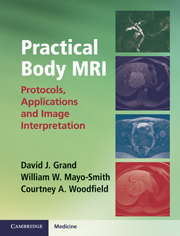Book contents
- Frontmatter
- Contents
- Preface
- To the reader
- Acknowledgments
- Glossary of terms andabbreviations used in Body MRI
- Section 1 Body MRI overview
- Section 2 Abdomen
- Chapter 2 Liver
- Chapter 3 Pancreas and biliary tree
- Chapter 4 Kidneys
- Chapter 5 Adrenal glands
- Chapter 6 MRI enterography
- Section 3 Pelvis
- Section 4 MRI angiography
- Index
- References
Chapter 6 - MRI enterography
from Section 2 - Abdomen
Published online by Cambridge University Press: 05 November 2012
- Frontmatter
- Contents
- Preface
- To the reader
- Acknowledgments
- Glossary of terms andabbreviations used in Body MRI
- Section 1 Body MRI overview
- Section 2 Abdomen
- Chapter 2 Liver
- Chapter 3 Pancreas and biliary tree
- Chapter 4 Kidneys
- Chapter 5 Adrenal glands
- Chapter 6 MRI enterography
- Section 3 Pelvis
- Section 4 MRI angiography
- Index
- References
Summary
MRI enterography protocol
Indications
This protocol is used to evaluate patients' with known or suspected Crohn's disease.
Preparation
IV contrast: 1 mmol/kg gadopentetate dimeglumine at 2 cc/s
Oral contrast: Have patient begin drinking the first 450 cc barium sulfate 0.1% 30 minutes prior to exam time. Give patient second 450 cc barium sulfate 0.1% 15 minutes prior to exam time. At exam time, give 450 cc water
2 L nasal oxygen
Start IV with at least 24-gauge needle; connect to power injector
Use 2-phased array coils to cover entire abdomen and pelvis
Glucagon IV 0.5 mg
Exam sequence
(1) Axial True FISP BH – Cover entire abdomen and pelvis. Anatomic overview. Identify suspicious bowel segments.
(2) Coronal True FISP BH – Cover entire abdomen and pelvis. Anatomic overview. Identify suspicious bowel segments.
(3) Axial T2 single-shot fast-spin echo FS BH – Cover entire abdomen and pelvis. Identify T2-bright signal within or adjacent to bowel wall. Evaluate for perianal disease.
(4) Coronal T2 single-shot fast-spin echo FS BH – Cover entire abdomen and pelvis. Identify T2-bright signal within or adjacent to bowel wall.
(5) Coronal volume-interpolated gradient echo BH pre-contrast – Identify anything T1-bright which could be mistaken later for enhancement.
(6) Coronal volume-interpolated gradient echo BH post-contrast 35 seconds – Identify abnormal mucosal hyperenhancement implying acute Crohn’s disease.
(7) Axial volume-interpolated gradient echo BH post-contrast ~ 2 minutes – Cover entire abdomen and pelvis.
(8) Coronal volume-interpolated gradient echo BH post 3 minutes – Identify delayed enhancement which, in the absence of early enhancement, indicates chronic, fibrotic disease.
- Type
- Chapter
- Information
- Practical Body MRIProtocols, Applications and Image Interpretation, pp. 64 - 70Publisher: Cambridge University PressPrint publication year: 2012



